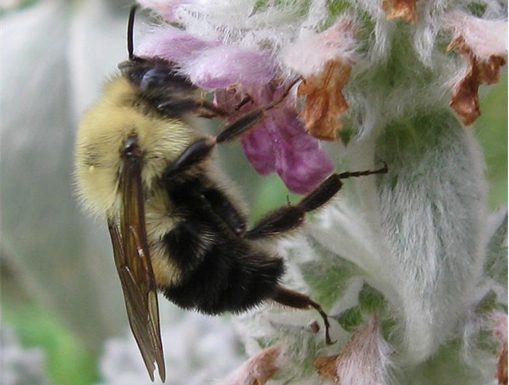Native pollinators

Fruits and vegetables that taste like summer—tomatoes, peppers, cucumbers, blueberries, raspberries, melons—are swelling and ripening in gardens and farms of our region. These crops would be far less abundant without the buzzing chorus of pollinating insects that provide their services for free.
Commercial honey bee and bumble bee operations make good use of the industrious Apidae species. Bumble bee pollination alone is worth $15 billion to greenhouse tomato growers, for example. But wild bees, butterflies, beetles, flies, and even birds and mammals all contribute to the flowers, fruits, and seeds we enjoy. Some 35 percent of our food crops depend on insect pollination. Natural ecosystems also rely on the pollination services at the heart of the food chain. A plump, well-pollinated mulberry might be a tasty snack for a hiker, but good fruit set is essential for wildlife like black bears that need large energy reserves to survive the winter.
The story linking flowering plants and insects goes back millennia. Before there were any flowers in the world only wind pollinated plants like pines grew. Then some plants evolved a handy trade-off system with hungry insects. By offering caloric nectar and pollen, advertised with scented, showy, come-and-get-it flowers, the plants got a pollen taxi to carry their genes from one flower to another to make new seeds.
One of the most promiscuous native pollinators this time of year is the boisterous bumble bee (bombus sp.). These (relatively) large, hairy beasts are hearty enough to fly even in the rain. They pollinate a host of native and cultivated plants thanks to the furry down that catches pollen at each flower visit. Unlike their foreign honey bee cousins, bumble bees can “buzz pollinate” plants like those in the tomato family, vibrating the flower parts in just the right way for pollination success. Slow to sting and fast flying, bumble bees are welcome and effective pollinators.
Native bees and other local pollinators need advocates who are willing to take extra precautions with pesticides. As Colony Collapse Disorder threatens honey bees, it is in our best interest to pay special attention to the needs of pollinating species. Native bees need undisturbed natural areas to forage and nest in all year long. Many species nest underground in old rodent dens, or burrow in small holes in logs. You can attract helpful insects to your own garden by supporting land conservation efforts in your neighborhood and by leaving plenty of natural nesting and foraging areas on your property. To find out how to choose native plants our local pollinators love and even how to supply nesting boxes for native bees, check out the website of the Xerces Society for Invertebrate Conservation.
Dana Powell wrote this article while interning for the LandTrust for Central North Carolina in 2011. At the time she was a student at Duke University.
Photograph by Dana Powell
Dana Powell